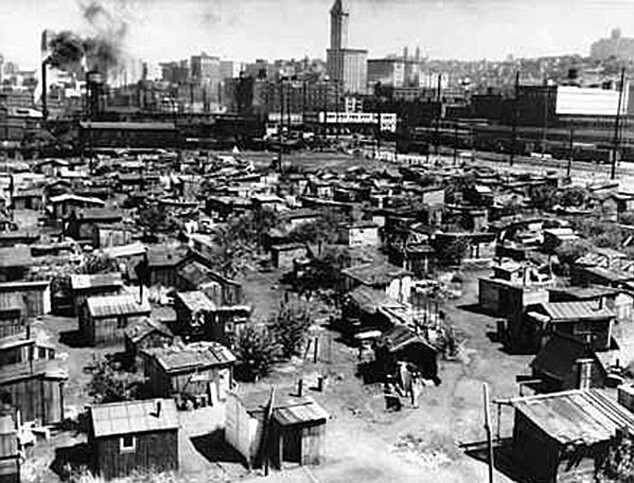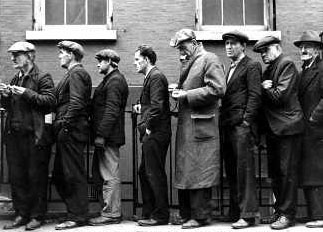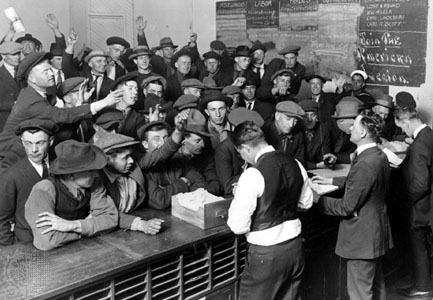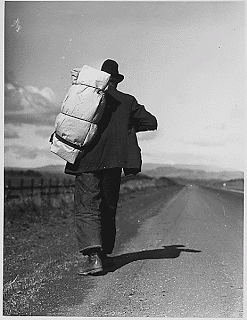Trainwreckovery

While so many are busy talking about eating dog and composite girlfriends, spiking the bin Laden football giving campaign speeches and posing for really stupid pictures in Afghanistan there are nearly 30 million of their fellow Americans who are wondering if, not when but IF, they will ever get back to work again.
Wondering IF they will ever feel like they are contributing again.
Wondering IF they will ever be able to lift the sinking feeling of despair and depression when they wake up every morning to begin another day full of "Thanks But No Thanks"
Wondering IF they will ever again have a day free of the adrenaline induced panic attacks when the phone rings and it's yet another creditor asking IF they plan to pay their bill this month. Or ever again.
Wondering IF their marriage is going to survive the ungodly stress brought on by their situation.
Wondering IF they will still find a way to pay their mortgage or rent this month.
Wondering IF they have enough to feed their kids.
Wondering IF anyone in D.C. even knows they're out here and understands what is happening to this America.

CNBC:
April's job report lived up to muted expectations, with the economy creating a meager 115,000 jobs during the month as the unemployment rate fell to 8.1 percent.
Job creation in the private sector was slightly better at 130,000, but overall the report painted a picture of a jobs market that had gotten a boost from unseasonably warm winter weather but now has cooled.
The service sector again accounted for most of the job creation, growing 101,000 while manufacturing added just 16,000, according to the Bureau of Labor Statistics. Governments cut a net 15,000 jobs for the month. The average work week was unchanged at 34.5 hours.
Though the headline number indicated job creation, the total employment level for the month actually fell 169,000. The disparity likely emanates from a drop in the labor force participation rate — or the level of Americans actively looking for jobs or otherwise employed — from 63.8 percent to 63.6 percent, its lowest level since December 1981.
The amount of discouraged workers swelled from 865,000 to 968,000, an increase of 12 percent. Those working part-time for economic reasons surged 181,000 to more than 7.8 million.
"In the weakest recovery since the Great Depression, more than four-fifths of the reduction in unemployment has been accomplished by a dropping adult labor force participation rate — essentially persuading adults they don't need a job, or the job they could find is not worth having," said University of Maryland economist Peter Morici.
Wall Street economists had been expecting the Bureau of Labor Statistics report to show 170,000 new jobs created and the unemployment rate![[cnbc explains]](green-energy/green-energy-576a3e38e6e9f.gif) holding steady at 8.2 percent.
holding steady at 8.2 percent.
The unemployment rate, which estimates the total percentage of jobless Americans but does not count those not actively looking for work, was last this low in January 2009, when President Obama took office. Total job creation, though, remains narrowly negative for the president and likely will be a contentious interview as Obama seeks a second term.
The miss in the nonfarm payrolls report led to a negative reaction on Wall Street, with the stock market trading lower in the morning and interest rates on government debt falling. The 30-year bond lost nearly 3 points in price to yield 3.09 percent.
An alternative measure of unemployment which counts those who have stopped looking for work held steady at 14.5 percent.
"We are stuck with labor demand that is just too darn weak," economist Jared Bernstein said on CNBC's
"Squawk Box." "I'm not pleased with what I'm seeing." (See the full interview here.)
The BLS also indicated an upward revision to its March numbers, from 120,000 to 154,000.
Long-term unemployment remains a problem, though it eased somewhat in April. The total amount of those out of a job for more than 27 weeks dipped from 5.3 million to 5.1 million, while the average duration of unemployment fell from 39.4 weeks to 39.1 weeks.
read the rest here but keep in mind that the biggest reason long term unemployment fell in April was because people could no longer collect unemployment, the 99ers, and were no longer counted.
The service sector again accounted for most of the job creation, growing 101,000 while manufacturing added just 16,000, according to the Bureau of Labor Statistics. Governments cut a net 15,000 jobs for the month. The average work week was unchanged at 34.5 hours.
Though the headline number indicated job creation, the total employment level for the month actually fell 169,000. The disparity likely emanates from a drop in the labor force participation rate — or the level of Americans actively looking for jobs or otherwise employed — from 63.8 percent to 63.6 percent, its lowest level since December 1981.
The amount of discouraged workers swelled from 865,000 to 968,000, an increase of 12 percent. Those working part-time for economic reasons surged 181,000 to more than 7.8 million.
"In the weakest recovery since the Great Depression, more than four-fifths of the reduction in unemployment has been accomplished by a dropping adult labor force participation rate — essentially persuading adults they don't need a job, or the job they could find is not worth having," said University of Maryland economist Peter Morici.
Wall Street economists had been expecting the Bureau of Labor Statistics report to show 170,000 new jobs created and the unemployment rate
![[cnbc explains]](green-energy/green-energy-576a3e38e6e9f.gif) holding steady at 8.2 percent.
holding steady at 8.2 percent.The unemployment rate, which estimates the total percentage of jobless Americans but does not count those not actively looking for work, was last this low in January 2009, when President Obama took office. Total job creation, though, remains narrowly negative for the president and likely will be a contentious interview as Obama seeks a second term.
The miss in the nonfarm payrolls report led to a negative reaction on Wall Street, with the stock market trading lower in the morning and interest rates on government debt falling. The 30-year bond lost nearly 3 points in price to yield 3.09 percent.
An alternative measure of unemployment which counts those who have stopped looking for work held steady at 14.5 percent.
"We are stuck with labor demand that is just too darn weak," economist Jared Bernstein said on CNBC's
"Squawk Box." "I'm not pleased with what I'm seeing." (See the full interview here.)
The BLS also indicated an upward revision to its March numbers, from 120,000 to 154,000.
Long-term unemployment remains a problem, though it eased somewhat in April. The total amount of those out of a job for more than 27 weeks dipped from 5.3 million to 5.1 million, while the average duration of unemployment fell from 39.4 weeks to 39.1 weeks.
read the rest here but keep in mind that the biggest reason long term unemployment fell in April was because people could no longer collect unemployment, the 99ers, and were no longer counted.

Wall Street Journal:
U.S. Jobs Data Add to Fears of Spring Slowdown .
U.S. job growth slowed again in April and more Americans dropped out of the work force, a fresh sign that the economy could be settling into a sluggish spring.
Nonfarm payrolls grew by 115,000 last month, the Labor Department said Friday. The unemployment rate, obtained by a separate survey of U.S. households, ticked down a tenth of percentage point to 8.1%.
"The very modest 115,000 increase in US nonfarm payrolls in April will raise fears that the recovery is fading fast, just like it did at this time last year," said Paul Ashworth, chief U.S. economist at Capital Economics.
Economists surveyed by Dow Jones Newswires had forecast a gain of 168,000 in payrolls and for the jobless rate to remain at 8.2% in April.
the rest here

Investors Business Daily:
Labor Force Shrinks As Jobless Swell Disability Ranks
The civilian labor force shrank in April by 342,000 workers, and remains below where it stood when the economic recovery started 34 months ago, according to data released Friday by the Bureau of Labor Statistics. Had the labor force not declined, unemployment would have been 8.3% in April, instead of the 8.1% reported.
That same month, more than 225,000 workers applied for Social Security disability benefits, and nearly 90,000 were enrolled, according to new data from the Social Security Administration.
Compared with June 2009, the month the economic recovery officially started, the labor force has shrunk by 365,000, a trend that has never occurred in any post World War 11 recovery. Those saw the labor force climb by the millions by this point in their recoveries, even as unemployment rates were driven down.
The decline in the workforce combined with the growing population has pushed the labor force participation rate — which compares those working or looking for a job the working age population — fell again in April to 63.6%. That's down from 65.7% in mid-2009, and is the lowest it's been since 1981.
Economists note that the shrinking labor force has masked the true size of the unemployment problem, since people who quit looking for a job are no longer counted as unemployed.
In fact, had the labor force participation rate had stayed where it was in June 2009, the unemployment rate would be around 11%.
Many of those who've quit looking have instead signed up for disability benefits.
So far this year, nearly 1 million workers have applied to get on the disability program. According to the Social Security Administration, more than a third will eventually be enrolled in the program.
Almost 90,000 workers enrolled the program in April, pushing the total for new enrollees over 333,000 in the first four months of the year.
If you add in spouses and dependents, the number of beneficiaries added to the program so far this year climbs to 539,000.
As IBD reported recently, more than 5 million workers and their families have enrolled in the disability program since Obama took office.
A report last fall from the Obama administration's economic advisers warns that the mass exodus of workers who can't find a job onto the disability rolls poses a long-term risk to the economy, since once enrolled, these workers almost never return to the active workforce. This can, the report said, result "in a loss to society of the economic contribution those workers could have made."

Breitbart:
29.7 Million Seek Work
People ask, why all the talk about dogs and contraceptives? The reason is: jobs.
Tomorrow the Labor Department will release its April employment report. If the rate goes down, the administration will brag a bit, but they won't dwell on it. They know that the unemployment rate does not reflect the actual number of people who need work. Did you ever wonder how many of them are really out there?
Let's put in a pre-recession, real numbers perspective. In July 2007, at the peak of the bling-years boom, there were 146.1 million people employed, 7.1 million unemployed, and 4.5 million working part-time "for economic reasons," which added to the unemployed gives the number for "underemployed” (U6). There were 78.7 million people not in the labor force. The unemployment rate was 4.6%.
Last month, in March 2012, there were 142 million employed, 12.7 million unemployed, 7.7 million U6, and 87.9 million "not in the labor force. The unemployment rate is now (supposedly) 8.2%.
With 154.7 million in the labor force, 1% represents about 1.55 million people. The unemployment rate is 3.6% higher, so there ought to be about 5.4 million less people working than five years ago. That's not true. There are indeed 5.6 million more unemployed, but there are also a staggering 9.2 million more people "not in the labor force," most often because they can't find a job. That means the total number of additional people actually out of work compared to 2007 is 14.8 million, or 9.7% of the labor force. Add that to the original 4.6%, and the actual rate of unemployment is about 14.3%. Also, there are 3.2 million more people working part-time jobs because they can't find full-time work. Let’s add. Today, there are 18 million more people not working or unable to find the job they want than in 2007. Add in the original 7.1 million already unemployed in 2007, plus the original 4.6 million U6, and the total is 29.7 million. In a universe of 155 million workers, the real U6 rate is thus approximately 19%. This is all Dept. of Labor data, offering an apples to apples comparison.
These 29.7 million people are anonymous, nameless, faceless. But the President's team knows they are out there, and that they are highly likely to vote. So they don't want to talk about jobs. They want to change the subject. Hence, more talk about dogs and contraceptives.

CNN (yeah, really, no kidding):
The 86 million invisible unemployed
 Last year, 86 million Americans were not counted in the labor force because they didn't keep up a regular job search. Most of them were either under age 25 or over age 65.
Last year, 86 million Americans were not counted in the labor force because they didn't keep up a regular job search. Most of them were either under age 25 or over age 65.NEW YORK (CNNMoney) -- There are far more jobless people in the United States than you might think.
While it's true that the unemployment rate is falling, that doesn't include the millions of nonworking adults who aren't even looking for a job anymore. And hiring isn't strong enough to keep up with population growth.
"We've been getting some job growth and it's been significant, but it hasn't yet been strong enough that you start to get people re-engaging in the labor market," said Keith Hall, a senior research fellow at the Mercatus Center and former commissioner of the Bureau of Labor Statistics.
Job market dropouts
A person is counted as part of the labor force if they have a job or have looked for one in the last four weeks. As of April, only 63.6% of Americans over the age of 16 fell into that category, according to the Labor Department. That's the lowest labor force participation rate since 1981.It's a worrisome sign for the economy and partly explains why the unemployment rate has been falling recently. Only people looking for work are considered officially unemployed.
Jason Everett, for example, wouldn't be counted.
Out of work for nearly three years now, Everett has given up his job search altogether.
Instead, the unemployed plumber and Air Force veteran takes a few community college courses and looks after his two children while his wife is the primary breadwinner.
"I'm not even totally convinced the college degree is really going to help at this point, but I figure at least I'll be doing something," he said.
The unofficially unemployed
Last year there were 86 million people who didn't have a job and weren't consistently looking for one, according to Labor Department data.
Older people, ages 65 and over, account for more than a third. Young people between 16 and 24 make up another fifth. More than half don't have a college degree and more than two thirds are white.
Many of the teens and 20-somethings may be enrolled in either high school or college full-time. And many of the over 65 crowd are probably retired.
But what about the other 36 million folks who fall in between?
The truth is, the Labor Department simply doesn't know why they're not in the labor force. Many may be staying home with children or other relatives. Some may have gone back to school or retraining programs. Others could be disabled and unable to work, and some may have retired early.
"Even in the best of times, there are millions of people who don't want to work for a variety for reasons," Hall said.
But he suspects the number of "disengaged" Americans, like Everett, is higher than usual as a direct result of the recession.
About six million people claim they want a job, even though they haven't looked for one in the last four weeks. If they were to all start applying for work again, the unemployment rate would suddenly shoot up above 11%.
"At this point, the labor market is worse than people realize because people are discouraged. Certainly, a large number of workers have given up on the job market," Hall said.
That said, the decline in labor force participation is not a new problem. After peaking at 67.3% in early 2000, the rate has been falling ever since.
Researchers at the Chicago Federal Reserve attribute a large part of the decline to the recent recession and lackluster recovery, but the other half to long-term demographic trends.
For example, as more women entered the labor force between the 1960s and 1990s, the participation rate rose rapidly. That effect may have plateaued since then.
Meanwhile, as Baby Boomers entered their prime working years, they also drove the participation rate higher. Once they started hitting their 50s and 60s though, many started transitioning into retirement.
Finally, teenage jobs have been on the decline and college enrollment picked up in the last decade, leading more young people to not be counted in the labor force.
As these trends continue, the Chicago Fed expects the labor force participation rate will keep falling, hitting 62.4% by 2020.
That poses a problem for a variety of reasons.
It hits tax revenue and makes it harder to fund social safety nets like Social Security. Not to mention, it's likely to increase income inequality.
Most importantly though, it makes the U.S. economy less productive and weighs on growth.

FUCK YER HOPE AND CHANGE

- More Lies, Damned Lies, And Statistics
In the continuing series of lies and misrepresentations from our gov't, BLS and the media I give you today's unemployment report... CNBC: US added 295,000 jobs in Feb vs. 240,000 est; unemployment rate at 5.5% vs. 5.6% est Job creation boomed...
-
THE ONLY UNEMPLOYMENT HEADLINES THAT MATTER EVERYTHING ELSE IS SMOKE AND MIRRORS AND HOODOO ECONOMICS 8.5 Million Americans Left Labor Force In Obama's First Term The Bureau of Labor Statistics released jobs numbers for January Friday showing...
- Figgers.
IBD: Disability Ranks Outpace New Jobs In Obama Recovery By JOHN MERLINE, INVESTOR'S BUSINESS DAILY View Enlarged ImageMore workers joined the federal government's disability program in June than got new jobs, according to two new government...
- No Depression
Like I've been saying. . . Daniel Amerman, with thanks to Will: Making 9 Million Jobless "Vanish": How The Government Manipulates Unemployment Statistics By Daniel R. Amerman, CFAOverviewWhen we look at broad measures of jobs and population, then...
-
Mike Shedlock: Digging Still Deeper In Friday's Jobs Report; What's the Real Unemployment Rate? Every month the government posts the unemployment rate yet few know where the unemployment rate comes from, how it is determined, and the relationship...
